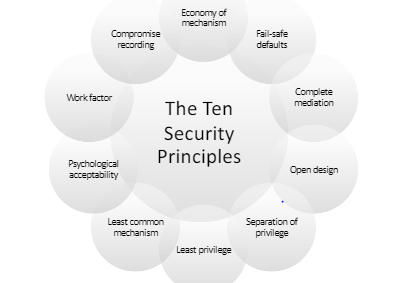1.4 Security Principles
1.4 Security Principles
security principles
- 1975 paper by Saltzer and Schroeder.
The Ten Security Principles
Economy of mechanism
- simplicity the design and implementation of security measures.
Fail-safe defaults
- the default configuration of a system should have a conservative protection scheme.
- if no access rights are explicitly specified for a
certain subject-object pair (s, o)(like access control matrix), then all types of access toobject oare denied forsubject s.
Complete mediation 调解
- every access to a resource must be checked for compliance with a protection scheme.
- it can be risky if
permissions are checked the first timea program requests access to a file, but subsequent accesses to the same fileare not checked againwhile the application is still running. - Example:
- online banking web site, 15 minutes, has elapsed
Open design
- the security architecture and design of a system should be made publicly available.
- allows for a system to be scrutinized by multiple parties, early discovery and correction of security vulnerabilities caused by design errors.
security by obscurity
- opposite of Open design, known a tries to achieve security by keeping cryptographic algorithms secret has been historically used without success by several organizations.
Separation of privilege
- multiple conditions should be required to achieve access to restricted resources or have a program perform some action.
- limit the damage caused by a security breach of any individual component.
Least privilege
- Each program/user should operate with the bare minimum privileges necessary to function.
- need-to-know: the military concept.
Least common mechanism
- systems with multiple users, mechanisms allowing resources to be shared by user should be minimized.
Psychological acceptability
- user interfaces should be well designed and intuitive 有直觉力的,
- all security-related settings should adhere to what an ordinary user might expect.
Work factor
- the cost of circumventing a security mechanism should be compared with the resources of an attacker when designing a security scheme.
Compromise recording
- record the details of an intrusion than to adopt more sophisticated measures to prevent it.
This post is licensed under CC BY 4.0 by the author.

Comments powered by Disqus.